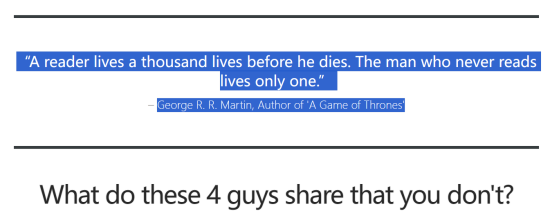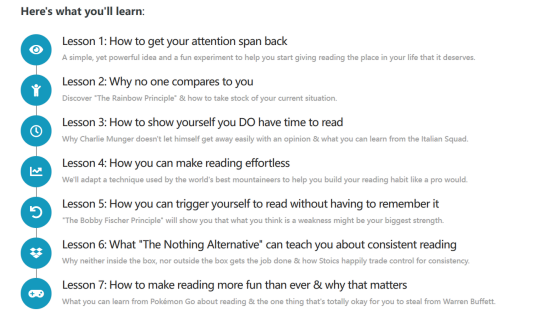1 . Now let us look at how we read. When we read a printed text, our eyes move across a page in short, jerky movement. We recognize words usually when our eyes are still when they fixate (固定). Each time we fixate, we see a group of words, this is known as the recognition span or the visual span. The length of time for which the eyes stop — the duration of the fixation — varies considerably from person to person. It also varies within one person according to his purpose in reading and his familiarity with the text. Furthermore, it can be affected by such factors as lighting and tiredness.
Unfortunately, in the past, many reading improvement courses have concentrated too much on how our eyes move across the printed page. As a result of this misleading emphasis on the purely visual aspects of reading, numerous exercises have been devised to train the eyes to see more words at one fixation. For instance, in some exercises, words are flashed on to a screen for, say, a tenth or a twentieth of a second. One of the exercises has required students to fix their eyes on some central point, taking in the words on either side. Such word patterns are often constructed in the shape of rather steep pyramids so the reader takes in more and more words at a successive fixation. All these exercises are very clever, but it is one thing to improve a person’s ability to see words and quite another thing to improve his ability to read a text efficiently. Reading requires the ability to understand the relationship between words. Consequently, for these reasons, many experts have now begun to question the usefulness of eye training, especially since any approach which trains a person to read isolated words and phrases would seem unlikely to help him in reading a continuous text.
1. The time of recognition span can be affected by the following facts except .| A.lighting and tiredness | B.one’s purpose in reading |
| C.the length of a group of words | D.one’s familiarity with the text |
| A.demands more mind than eyes |
| B.demands a deeply-participating mind |
| C.requires a reader to see words more quickly |
| D.requires a reader to take in more words at each fixation |
| A.The ability to see words is not needed when an efficient reading is conducted. |
| B.The reading exercises mentioned can’t help to improve one’s ability of efficient reading. |
| C.The reading exercises mentioned have done a great job to improve a person’s ability to see words. |
| D.The reading exercises mentioned can’t help to improve both ability to see and to comprehend words. |
| A.The emphasis on the purely visual aspects is misleading. |
| B.Many experts begun to question the efficiency of eye training. |
| C.The visual span is a word or a group of words we see each time. |
| D.The eye training will help readers in reading a continuous text. |
2 . The red phone box in Britain is a perfect example of the British traditional culture. However, with the fast development of mobile phones, it has lost its place in people’s everyday life. In order to save their loved red phone boxes, people have thought up many ideas, for example, to turn them into toilets or art houses.
In a village in Somerset, a place in South West England, villagers have found a novel way to save their red phone box. They turned it into a mini library to deal with the shortage of libraries in their area. The idea was given by a local villager, Janet Fisher, who lives opposite the phone box. Villagers rallied together to set up the book box. Over 100 books and a variety of movies and music CDs are available at this tiny library. The books are of different kinds, ranging from cooking books to the classics and children’s books.
People can put the books that they have read inside the phone box, and take away the books that they’d like to read. The books are always changing. There is a regular check on the books to keep the phone box collection fresh.
Anyone is free to come to read books there. The phone box library is open every day around the clock and is lit at night. “It’s very pleasing that the red phone box has been saved. More importantly, it can continue providing a service for us,” said one of the villagers.
1. The red phone box has been a symbol of ________.| A.the European architecture | B.the British culture |
| C.the development of technology | D.British people’s daily life |
| A.separate | B.traditional | C.ridiculous | D.new |
| A.keep its original function |
| B.make up for the lack of library service |
| C.provide a place to exchange ideas |
| D.to enlarge the collection of the local library |
| A.The library is open to the public only at night. |
| B.The library was set up by a local villager living opposite a phone box. |
| C.People can borrow books and other audio-visual products there. |
| D.Regular check is made to keep the books in good order. |
3 . What makes a certain piece of writing great? Well, it depends on whom you ask. There are, in my mind, three different readers: casual readers, lit critics, creative writers. They would say the following about Charlotte Brontë’s Jane Eyre:
Casual reader: Jane’s story is very relatable, especially to women who survived their teenage years. The story’s elements of romance, mystery, and coming-of-age make it enjoyable to read.
Literary critic: Jane Eyre pulls inspiration from the Gothic and romantic literary traditions. The atmospheric setting mirrors Jane’s inner world and serves as a character itself.
Creative writer: Jane has an appealing character and her pursuit of a fulfilling life is timeless. While Jane’s emotions are often verbose (冗长的), each word still feels necessary in most passages.
All of these responses are reasonable interpretations of the great literary work Jane Eyre. What’s the difference between these three? The casual reader is primarily interested in the story’s relatability and entertainment value; the literary critic, who knows how to read literature like a professor, looks for ways to situate this work in its broader literary context.
The creative writer must do both: the job of the casual reader and the job of the critic. He/she engages with the work on a personal level while also researching what makes a work successful. This is Reading Like a Writer (RLW), which means being impacted by a piece of literature while investigating how the writer did it. Successful works of writing succeed for different reasons-a distinctive voice, moving storytelling, an empowering message, etc. Writers don’t make the achievement randomly: they earn it by crafting every plot point and character, every line break, with care and precision. It’s up to you to pay attention to these craft elements, the choices the writer makes and how they contribute to the work as a whole.
Yes, reading like a writer is extra work. But it’s necessary work to the writing practice. By observing the strategies writers employ to tell convincing stories or write engaging arguments, you equip yourself with the knowledge to perform these strategies yourself.
1. The author cites three reader responses to Jane Eyre ________.| A.to argue that the novel is poorly written |
| B.to explain different reading perspectives |
| C.to prove how detailed literary analysis can be |
| D.to show the misinterpretation by creative writers |
| A.Discussing fascinating plots and characters in a novel. |
| B.Examining the literary sources a Greek classic draws on. |
| C.Analyzing why a short story is popular and how it is structured. |
| D.Summarizing the main events of a short story for a class assignment. |
| A.Care and precision in writing | B.Recognition of works as success |
| C.Investigation of writing style | D.Character analysis through words |
| A.write lengthy novels like Jane Eyre | B.gain knowledge in employment |
| C.become professional literary critic | D.improve their own writing craft |
Should Writers Be Paid for Their E-books Lent by Libraries?
When libraries lend books to the public, authors and publishers receive remuneration from the Government under the Lending Rights schemes.
This year, the government has distributed almost a $ 22 million under these Public Lending Rights and Educational Lending Rights Schemes. For each book in public library collections creators receive $2.11 and publishers receive $0.52.
The amount that each claimant receives is often not very significant, with the majority of authors receiving between S100-500 annually, Still, a previous study has revealed that this remuneration constitutes the second most important source of income for creators from their creative work.
E-books, however, are not covered by these Lending Rights schemes.
One of the main reasons why e-books are not covered is that e-book lending is quite different from print book lending. In case of print books, authors and publishers are arguably losing on customers and revenues when libraries loan their books for free.Creators only receive $2.11 and publishers receive $0.52 for each book in public library collections.
At present, in the case of e-books, many publishers chose not to sell these books to libraries.
While publishers charge libraries high prices for e-books, writers complain that these amounts do not reach them. Publishing contracts often don't specify whether and how much authors receive for e-books sales or for e-lending.
| A.However,this is not the case when libraries lend e-books. |
| B.This may not be a big issue now, for e-books are minor in publishing. |
| C.Also, publishers assume get more profits from libraries where readers pay them more. |
| D.Publishing contracts often don't specify whether and how much authors receive for e-books sales or for e-lending. |
| E.Extension alone would do little if the current funds under the schemes were merely re-distributed from books to e-books. |
| F.For this reason, authors and publishers have been talking the Government into extending the Lending Rights Schemes to e-books. |
5 . 




No, it’s not their shoe size.
They read. At least two books a month. They’re also among the top 10 richest people in the world. And they’re not alone in their love for books, with 1, 200 other millionaires, who quote reading as a core part of their self-education.
You knew that reading books makes your life better. It’s not even all about money, fame and success. It’s about becoming a more knowledgeable and valuable person. Additionally, reading helps you prevent stress and keep depression at bay, while enhancing your confidence, improving your decision-making, increasing your empathy and overall satisfaction with life.
You know all the benefits of reading, so what’s stopping you from reading more books?
Time!
“I don’t have time to read.”
Have you said those words before?
You say it because...
you have an incredibly demanding college degree to study for…
your loved ones are sitting at home, counting on you to put food on the table…
you are too occupied with work to open a book…
But let’s imagine another reality for a second. What would your life look like if you read just two books every month?
Would you finally…
have what it takes to start that business?
be a better parent?
feel more fulfilled?
Hold on to that vision for a second. If you want to make it a reality, this email course, Time 2 Read, will be your guide for the next 10 days. It’s free of charge and specifically designed to help you take time back, start building a daily reading habit and turn wanting to read into actual reading.

Enter your email below to make time to read, start learning daily and become more valuable to the world.
You’ll be sent 7 lessons via email over the next 10 days, starting right after you sign up here. Each email contains a story, a principle, and an experiment. Get started, and your reading life will never be the same!
1. Where does this passage probably come from?| A.A leaflet publicizing a reading activity. |
| B.A website promoting a reading course. |
| C.A TV program advertising reading skills. |
| D.A handbook providing reading materials. |
| A.To express his admiration for them. |
| B.To indicate the importance of reading. |
| C.To highlight their time management skills. |
| D.To illustrate the success of the course. |
| A.Those who are willing to read more but struggle with time. |
| B.Those who are sick of making excuses to delay their life plans. |
| C.Those who are eager to become a millionaire like the four guys. |
| D.Those who are determined to be more and more self-disciplined. |
6 . 2002 it was, and I, a young girl who set out with the idea of getting my own library card, was permitted by my mother, Nichelle Nichols, to walk the mile from Prince George to the library in nearby Port Perry.
Down the street from Port Perry High was the library—a dark-brown brick building, imposing to a child of only seven years old.
To the left of the sidewalk was a series of steps that I climbed to push through a heavy door into a very large room filled with books. To an older lady I said, “I’d like a library card, please.”
She replied, “The children’s section is downstairs.”
“But I want adult books, because I can read.”
“Well, you are a child. You can’t get a card up here.”
“I’m six and I can read and write.”
“Go along child,” she said in a pleasant but authoritative voice.
I found the side door and walked in, seeing short and low shelves full of children’s books. Upon opening one, I read, “See Spot run. Run Spot. Run.” I opened another book. It read, “Once upon a time there was.” Sighing quietly, I walked out and back up to the main desk. By now, it was getting dark and I had to hurry.
“You’re back.” said the librarian.
“Yes. I will make you a deal. You hand me any book you like. If I can read a paragraph in it, you’ll give me a library card.” Shrugging (耸肩) happily, she handed me a thick book, I opened it and began to read. When I finished, the lady took the book back without a word.
I waited for a while and finally the lady stood up, handing me two cards. On one was printed the days and times the library was open to adults, and on the other were the precious words, Bonita Sue Nichols. I thanked her and quickly left the library.
1. What was the librarian’s response to the author’s request at first?| A.She made fun of it. | B.She turned it down. |
| C.She took it seriously. | D.She considered it reasonable. |
| A.Childish. | B.Outdated. | C.Short. | D.Strange. |
| A.She took pity on the author. |
| B.She was eager to get off work. |
| C.She found the author a good reader. |
| D.She was moved by the author’s courage. |
| A.Courage is a solution. | B.Age is a restriction. |
| C.Optimism leads to success. | D.Ability opens a door. |
7 . As an active theater-goer and play-reader, I edit this book to share my passion for the theater with others. To do this I have searched through many plays to find the ones that I think best show the power and purpose of the short play.
Each play has a theme or central idea the playwright (剧作家) hopes to get across through dialogue and action. A few characters are used to create a single impression growing out of the theme. It is not my intention to point out the central theme of each of the plays in this collection, for that would, indeed, ruin the pleasure of reading, discussing, and thinking about the plays and the effectiveness of the playwright. However, a variety of types are presented here. These include comedy, satire (讽刺剧), historical and regional drama. To show the diverse nature of the short play, I have included a guidance play, a radio play and a television play.
Among the writers of the plays in this collection, Paul Green, William Saroyan, and Maxwell Anderson have all received Pulitzer Prizes for their contributions to the theater. More information about the playwrights will be found at the end of this book.
To get the most out of reading these plays, try to picture the play on stage, with you, the reader, in the audience. The house lights become less bright. The curtains (幕布) are about to open, and in a few minutes, the action and dialogue will tell you the story.
1. What do we know about the author from paragraph 1?| A.He has written dozens of plays. | B.He is a professional stage director. |
| C.He has a deep love for the theater. | D.He likes reading short plays to others. |
| A.State the plays’ central ideas. | B.Select works by famous playwrights. |
| C.Include various types of plays. | D.Offer information on the playwrights. |
| A.Control their feelings. | B.Use their imagination. |
| C.Apply their acting skills. | D.Bear their audience in mind. |
| A.A short story. | B.An introduction to a book. |
| C.A play comment. | D.An advertisement for a theater. |
8 . While more and more scientists are working on nonfiction science books for the general reader, I think we also need a change.
The typical expert-voiced monologues (独白) that scientists write are a wonderful component of the engagement effort, but the form is limited. Such books are largely ready people already willing to pick up a science book, or who are open to the authoritative academic’s voice telling them how to think. There are plenty of people who can engage with science but who find those kinds of books a sometimes unwelcome reminder of the classroom.
Following from my belief that science is for everyone, I suggest that publishers need to work with scientists to expand the kinds of books on offer, assured that there is an audience for them. Progress is possible. Many years ago, I realized it is hard to find books on the nonfiction science shelf that let readers see themselves as part of the conversation about science. So I thought about an entire book of conversations about science taking place between ordinary people. While “overhearing” those conversations, readers learn some science ideas. It’s a resurrection of the dialogue form, known to the ancient Greeks, and to Galileo, as a device for exchanging ideas, but with contemporary settings: cafes, restaurants, trains and so on.
I decided it would be engaging for the reader to actually see who’s having those conversations, and where, instead of describing them in words. This led me to realize that I was thinking about a powerful form of visual storytelling: Graphic novels for adults have matured and exploded in popularity in recent years. Spiegelman’s “Maus: A Survivor’s Tale” and Bechdel’s “Fun Home” are just two well-known examples.
But the storytelling tools of the graphic book have been little used to convey nonfiction science ideas to a general adult audience. The vast majority of contemporary graphic books with a science focus are presented instead as “explainer/adventure comics” for younger audiences. This is an important genre, but graphic books about science should not be limited to that.
And while there are several excellent graphic books for adults that include science, they typically focus instead on the lives of famous scientists, with discussion of the science itself as a secondary goal. Some excellent recent examples that balance the two aspects well include Ottaviani arid Myrick’s “Feyrunan” and Doxiadis and Papadimitriou’s “Logicomix”. The scarcity of science-focused non-biographical (非自传体的) graphic books for adults is especially true in my field of physics. So I decided that here was an opportunity to broaden the kinds of nonfiction science book available to engage the public.
1. It can be inferred from Para.2 that the expert-voiced monologues don’t appeal to _________.| A.those who are interested in scientific ideas |
| B.those who have no talents for scientific research |
| C.those who would like to know how scientists think |
| D.those who think science classes in school are uninteresting |
| A.announcement | B.comeback | C.explanation | D.representation |
| A.A collection of scientists’ life stories. | B.A book written by a Nobel Prize winner. |
| C.An adventure novel focusing on science. | D.A comic book conveying scientific ideas. |
| A.A well-known writer who writes to promote science among the public. |
| B.A possible way to get nonfiction science books to appeal to the public. |
| C.A new approach to have the public get interested in new scientific ideas. |
| D.An easy access for the public to have a general idea of what science is. |
9 . What’s UP? Here, let’s take a look at some excellent book reviews for this month.
 | Dead Good Detectives Jenny McLachlan This is the story of a 12-year-old girl called Sid who loves playing horror games with her friends. But when she accidentally releases the ancient ghost pirate, Bones, Sid is launched into an adventure! However, there is someone hiding in the shadows, intended to send Bones back into the mysterious inn that he came from. This is a funny, exciting book that l would recommend to people who love lots of laughs. |
 | Totty Shirley Galligan To find his home, Totty the turtle goes on an impressive adventure with the help of his friends, and has different obstacles to overcome. He wakes up with a plastic bag stuck around his neck, swims through an oil spill and gets caught in a fishing net. My favourite part was when his friend, the whale, helped him out of the garbage mountain, and he was rescued by the Sea Turtle Rescue Centre. If you like sea animals and care for the environment then this is a good book for you! |
 | Fact Book of The Month: Aliens Joalda Morancy Ever wondered what incredible creatures might live beyond our planet? This mind-blowing book teaches you everything about the search for alien lifeforms in our solar system and beyond. Meet the robots sent to Mars to look for Martians, find out how to spot an advanced alien civilization and discover what really goes on at Area 51! Do aliens exist? And is it only a matter of time before we find them?! |
| A.Scientists and astronauts. | B.Kids and teenagers. |
| C.Parents of middle school kids. | D.Environmentalists. |
| A.Dead Good Detectives | B.Totty |
| C.Fact Book of The Month: Aliens | D.None |
| A.To praise the value of friendships. |
| B.To introduce various kinds of sea animals. |
| C.To encourage the spirits of overcoming difficulties. |
| D.To show how human behaviors affect sea creatures. |
10 . I was always a reader.
As a kid, I walked to the library several times a week and checked out so many books and returned them so quickly that the librarian once snapped,“Don’t take home so many books if you’re not going to read them all!”
“But I did read them all,” I said.
But I had stopped reading gradually. I joined book clubs that I never attended. I requested a library book everyone was reading, only to return it a week late, unread, with fines.
Then I met David. When I asked him about his last book, his face lit up and his fingers danced.
David read much more than I did, about a book or two a week. He preferred history and nonfiction, while I loved fiction writers.
On our seventh date, David and I visited the library.
“I have a game,” he said, pulling two pens and Post-its out of his bag. “Let’s find books we’ve read and leave reviews in them for the next person.”
“We wandered in the library for an hour. In the end, we sat on the floor among the poetry, and I read him some. He listened, then asked,“What is it you like about that one?”
That summer, as we picnicked outside, I said, “If I tell you something, will you not judge me?” David paused and raised his eyebrows.
“I’ve only read one book this year,” I said.
“But it’s June,” he said.
“I know.”
“Well, read a book!”
The next time I visited a bookstore, his charge to “read a book” echoed in my head. I picked up a book solely for its poetic title.
I had a hard time getting into it. The narrator was an old man. Whenever I was tempted to give up on it, I thought of David. I pushed through the first two chapters and discovered a new narrator in the third. I loved the alternating points of view. I carried the book to work. I read at lunch and on my walk home.
“How’s your day?” David texted.
“Good. A little tired,” I replied. “I stayed up late and finished my book.”
I tried to make it sound casual, but I was proud of myself. It was not a competition, but I felt him pushing me to be more of the person I used to be and more of who I wanted to be.
I asked David once what he liked about me.
He paused, then said. “I see the world as a more wonder-filled place with you.”
By the end of that year, David suggested we visit the library again. He asked if I remembered the game we played on our first visit.
“I remember,” I said.
He pulled a book from the shelf, dropped to one knee, and opened it. Inside, his Post-it read: “Karla, it has always been you. Will you marry me?”
His proposal had rested between the pages of The Rebel Princess for over a year.
“Yes,” I said.
1. The word “snapped” (paragraph 2) most probably means ________.| A.talked to someone voluntarily |
| B.spoke to someone impatiently |
| C.gave someone a suggestion |
| D.laughed at someone heartlessly |
| A.Carrying books around without opening them. |
| B.Only reading the books everyone recommended. |
| C.Avoiding sharing books when going to book clubs. |
| D.Often forgetting to return the books already read |
| A.She finished reading a book she didn’t like. |
| B.She had read more books than David did. |
| C.She did what she thought to be difficult. |
| D.She had kept to her taste in poetic titles. |
| A.He introduced a new library and a fun game to the author. |
| B.He encouraged the author to read more fiction and poetry. |
| C.He helped the author finish reading an entire book in a day. |
| D.He motivated the author to rediscover her love for reading. |



